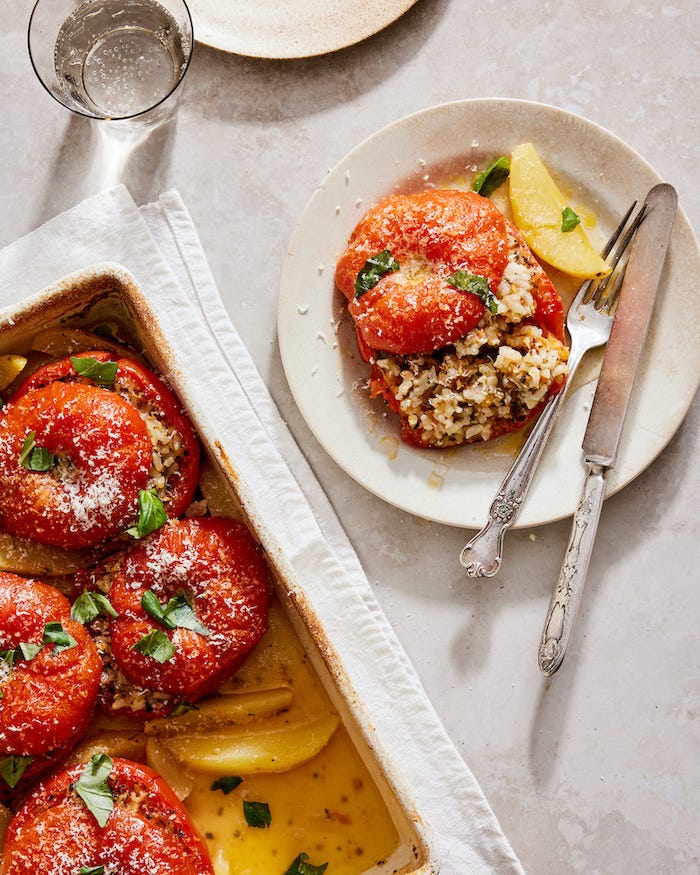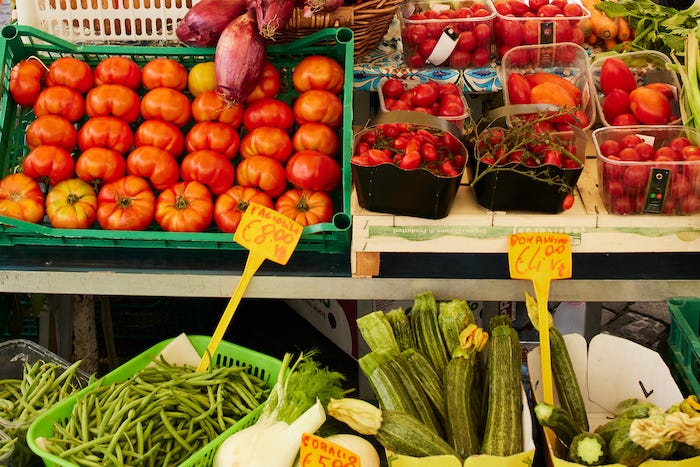

Discover more from The Jewish Table
How Do You Write A (Really Good) Recipe?
Plus: Happy birthday Portico! And The Four Questions with Lara Rabinovitch
Back to School Discount! Summer’s on the way out, but the good vibes don’t have to be. From now through September 6, new paid subscriptions to The Jewish Table are 20% off. Paid subscribers get weekly recipes and stories from around the Jewish world, and access to the full recipe archive. There’s a lot of excellent high holiday recipe inspiration coming up in the next few weeks, so if you’ve been meaning to upgrade to paid, now’s an excellent time.

Hello The Jewish Reader readers,
This week’s newsletter is chock full with late-summer goodness. In here you’ll find:
The recipe for these sumptuous stuffed tomatoes (and creamy potato wedges!) from Portico
“The Four Questions” interview with Lara Rabinovitch about her Jewish deli museum exhibit
A behind-the-scene’s glimpse into developing recipes that actually work
But first a celebration because somehow, tomorrow is the 1 year anniversary of Portico: Cooking and Feasting in Rome’s Jewis Kitchen’s publication date!
I distinctly remember the mix of excitement, anxiety, hopefulness, and exhaustion I was feeling this time last year. Putting something you care about out into the world is a vulnerable experience. And I think we feel that vulnerability most acutely in the moments right before. I felt oddly calm on publication day itself—a sense of “I’ve left it all on the field, let’s do this.” But in the days leading up to pub day, particularly the day before, I was a bundle of nervous energy.
The last 12 months have been unbelievably hard—in so many ways. But the experience of sharing Portico with readers has brought nothing but abundant joy. I remain so thankful to everyone here for your support along the way.
And…I have some exciting news. If you had a chance read my recent newsletter, On Disappointment, you might remember that I was pretty bummed that Portico did not get nominated for a James Beard Award. I’m honestly still a little bummed about it, though I firmly believe that doing/valuing the work is far more important than any accolade.
So I was thrilled (and definitely humbled) to find out last week that Portico was nominated for an IACP Award. I’d honestly almost put IACP out of my mind because I didn’t want to feel that same disappointment again. So when I got the notification that I’d been nominated, it was a double shock. On September 26, Yoshie and I will head to the International Association of Culinary Professionals Awards in Brooklyn to find out if Portico is this year’s winner in the international books category. But honestly? Regardless of the outcome, I am already so grateful to know that Portico has touched people’s lives and brought joy to their kitchens.
In honor of Portico’s first birthday and the exciting IACP nom, I thought I’d share one of my favorite recipes from the book: Stuffed Tomatoes with Rice (Pomodori Con Riso). They are a fixture of the Roman Jewish table and the recipe offers a master class in using simple ingredients (just tomatoes, potatoes, rice, garlic, basil, olive oil, s&p) to make something extraordinary. With tomato season in glorious full peak, there is no better time to make them than right now. Scroll down to read more about the dish and find the recipe.

How Do You Write A (Really Good) Recipe?
As a cookbook author, recipe development is a central part of my job. The longer I do it, the more I appreciate how challenging the process can be—and how rewarding it is to get it right. Case in point: the Chocolate Marble Cake recipe from The Jewish Cookbook. I tested that recipe 6 or 7 times with disappointing results. It tasted fine, but not great—you know? Finally, after tweaking the recipe for the 8th time, something clicked. Slicing into that perfectly swirled, perfectly sweet, perfectly tender cake was a Top 5 Life Moment. No joke.
So what does this anecdote have to do with you? Fair question. I believe that good recipes are worth remembering and worth sharing, regardless of whether you develop them for a living or not.
One of the things I hear most from people at cookbook events is that they are so sad they never wrote down how to make that x, y, or z dish from their mom, bubbe, or other treasured family member. They can distinctly remember how delicious the dish tasted, but have no instructions for how to recreate it or pass it on to the next generation.
Other folks have an intuitive knack for whipping up magic in the kitchen, but don’t have the tools to translate the wisdom in their fingers into something tangible they can share with others.
The bottom line is, recipe development is harder than it seems. But you don’t have to be a professional food writer to find value in recording your kitchen successes. Besides, the process is both rewarding and delicious. So whether you want to capture a treasured family dish or write down something genius that came out of your kitchen, here are some steps to set you on the path of recipe writing success:
Identify your source (or sources)
Before you turn on the stove, consider your source/s. Are you starting with a vague “recipe” your bubbe wrote down years ago? Are you starting from a memory of something you ate as a child? Are you starting from a couple of recipes you saw the internet that you want to combine into something new? Are you starting with a dish you literally envisioned in a dream? (Hey, it happens!) Everything new must start from somewhere, so your first step is to gather whatever source materials you have access to.
Write down what you know/don’t know
At their essence, recipes are a set of ingredients + instructions or clues for what to do with those ingredients. After identifying your sources, write down what you know, or think you know. Maybe you remember that your mom’s borscht recipe used 1 large bunch of beets, or your dad’s famous pancakes used a combination of whole wheat and buckwheat flours. That’s great info to start with! Write it down. Then add anything you don’t know, like how many carrots and onions went into that borscht, or whether those pancakes used buttermilk or regular milk.
If similar recipes exist on the internet or in cookbooks you have access to, take a peek at a few as reference. Don’t copy down the recipes verbatim (of course), but do use them for hints on ratios or potential ingredients you might be forgetting.
Format this information into a first recipe draft that will serve as your starting point. Put question marks by anything you aren’t sure about. Remember, it does not have to be correct just yet—it’s just a place to start. For the borscht it might look something like this:
Mom’s Old World Borscht
Serves 8 (?)
3 tablespoons (?) vegetable oil
1 large onion (?), finely chopped
2 large carrots (?), peeled and chopped
1 large bunch beets, stems removed, peeled and chopped
etc.
Heat the oil in a big soup pot over medium (?) heat. Add the onion and carrots and let them cook, stirring occasionally, until softened, (?) minutes. etc.
Check Your Formatting
Like with any piece of writing, recipe writing has guidelines that make them easier to follow:
Ingredients should be listed in the order they show up in the instructions.
Where applicable (especially with produce), ingredient amounts should be followed by preparation steps. So, “1 bunch beets” should be followed by “stems removed, peeled, and chopped” The goal is to get all the prep out of the way before you start the actual cooking.
If the recipe has more than one element (like a pie crust and a pie filling), list the ingredients for each element separately, starting with the ingredients for the part you should make first.
For the instructions, give each step its own paragraph.
Include clues in the instructions about how long things should cook, whether or not you to cover the pot, how often you stir etc.
For recipe with separate elements, introduce each one when you start it. So, 1. Make your pie crust: etc…. 2. Make your filling:…
Use sensory language
There are a lot of numbers in recipes: ingredient amounts, oven temperatures, cook times... But a good recipe also requires sensory-based instructional language. For example, what should the borscht look, smell, feel, or taste like when it’s done? Has the liquid in the pot reduced? Are the carrots falling apart or just barely tender? Include this information in your instructions so readers know what to look out for as they cook.
Make the recipe and take notes
Once you have your draft recipe, make it following your ingredients and instructions and take copious notes! Did your onions burn at high heat? Make a note to try medium heat for the next go around. Was your cake still raw at 40 minutes in a 350˚F oven? Indicate that you should either nudge the heat up to 375˚F or bake for 10 to 15 minutes longer next time.
Use your notes to make changes to your draft recipe. Then try again and repeat the process until you have answers for all of your question marks, and it tastes just right. Sometimes this process will take 2 tries, other times longer. Be patient—keep tweaking and making notes and you’ll get there!
Check your formatting again
Once you have your finished recipe, give it one more close read through. There will almost certainly be a mistake or two in there, no matter how careful you were while testing. (I unfortunately know this from experience.) Double and triple check before sharing the recipe!
For more recipe writing advice (and food writing wisdom in general), check out Dianne Jacob’s website and newsletter. I read her book Will Write For Food way back when I was a baby food writer, and have turned to her for advice along the way. She’s the GOAT!
The Four Questions Interview: Lara Rabinovitch
Welcome to the latest installment of The Four Questions, The Jewish Table’s semi-regular interview segment featuring Jewish food luminaries. This week I’m excited to be joined by Lara Rabinovitch, a Toronto-based writer, producer, and co-curator of the museum exhibition, I’ll Have What She’s Having: the Jewish Deli.
Rabinovitch holds a PhD in Jewish food history from NYU, and has worked on many projects throughout the years including being a consulting producer on the documentary, “City of Gold” about legendary Los Angeles food critic, Jonathan Gold. Her writing has also been published in The New York Times and the Globe & Mail, among other publications. But I am most impressed—and jealous!—of her work, along with Cate Thurston and Laura Mart, on the I’ll Have What She’s Having exhibit, which debuted at the Skirball Center in 2022.
Since then, the exhibit has travelled to other major delicatessen cities including New York and Chicago, and is currently on view (through Sept 1—go see it this weekend!) at the Capital Jewish Museum in Washington DC. Starting next February, it will head south for its last stop at The Florida Holocaust Museum. Rabinovitch shared more about her team’s goals for I’ll Have What She’s Having, the process of collecting artifacts for a museum exhibit, and why she always has a dozen Montreal bagels in her freezer.
You co-curated a Jewish deli exhibit—what an absolute dream! Can you describe your and your co-curators’ goals for the exhibit?
The Jewish deli is such an important part of the American landscape. And when I say landscape I mean it literally because the Jewish deli is one of the most visible symbols of Jewish culture. When you think about synagogues or Jewish schools, these are places that are not made for all Americans. But a Jewish restaurant is open to all. When you walk into a Jewish deli, it is truly an American restaurant. The idea that the deli is both an American invention and institution was at the core of the original exhibit at Skirball.
Can you share more about your process when you were first collecting artifacts for the exhibit?
It is impossible to share the entire history of the Jewish deli in any one exhibit, so we weren’t trying to be definitive with the exhibit—we were trying to tell a story. My co-curators first looked at the materials Skirball had in their archives, and then I went out to search for additional information that could help shape a historical narrative. We went to the Center for Jewish history, to the New York Public Library’s menu collection, to the Library of Congress, and to specific deli families that we had relationships with, like Canter’s in LA, who had treasure troves of material from over the years.
As the exhibit travels to museums in other cities, somewhere between one quarter and one third of the materials get swapped out and tailored for local materials. So when it was in New York, the focus was on 2nd Avenue Deli and Katz’s Deli. And in Chicago, we worked with the family of Manny’s Deli to get materials from them. The deli is such an important institution to whatever community it is based in, that it felt important to localize the exhibit.
What are some of your favorite items in the exhibit?
We wanted the exhibit to capture a bit of the feeling and multi-sensory experience of visiting a deli—the sounds of the pots and pans, the feelings of the waitress elbowing you, the clamor, the smells. A museum can sometimes feel a little sterile, so we really worked to capture the heymish (homey) feel. I love the meat slicer and Canter’s mid-century cigarette dispenser in the exhibit! We also got some great neon signs from delicatessens that we borrowed from the Museum of Neon Art in California.
Another thing I really love is that we worked with a designer who helped us create realistic-looking faux deli foods—a pastrami sandwich, matzo ball soup, a bagel with lox, cheesecake—in the style of the Japanese plastic food phenomenon. There are also photos of politicians and famous people at delis, which helps show the intersection of Jewish life with American politics and culture throughout the years.
Tell me about your relationship to Jewish food from growing up.
My family has deep Montreal roots, and Montreal has its own unique Jewish food and deli culture. My grandmother always said, “You can take the girl out of Montreal, but you can’t take the Montreal out of the girl.” It is actually written on her gravestone! And it’s true. I left Montreal when I was little, but I’ve always found reasons to go back. I lived there as an adult for school and research, and travel there frequently. And I definitely always have a dozen Montreal bagels in the freezer.
Stuffed Tomatoes with Rice (Pomodori Con Riso)
There’s something about the alchemy of soft, basil-scented rice encased in tomatoes that have been roasted to the point of collapse, that is completely captivating. The layer of potatoes in the bottom of the baking dish, which turn creamy in the oven and soak up ample tomato flavor, simply gilds the lily. Pomodori con riso is traditionally served on Passover, since it is customary for Italian Jews to eat rice during the holiday. But I like to make them for alfresco dinners and lazy weekend picnics in the summer, when the tomatoes in the market taste like distilled sunshine.
Serves 4 to 6
1/2 cup (100 g) Arborio or Carnaroli rice, rinsed and drained
8 medium ripe tomatoes (about 2 ½ - 3 pounds / 1.1-1.3 kg)
1/4 cup (60 ml) extra-virgin olive oil, plus more for drizzling
3 medium garlic cloves, finely chopped
2 tablespoons finely chopped fresh basil, plus more for serving
Kosher salt and freshly ground black pepper
2 medium Yukon gold potatoes (about 1 pound / 454 g), peeled, halved lengthwise, and cut into ¼-inch thick wedges
Freshly grated Parmesan for sprinkling, optional
Bring a small saucepan half filled with water to a boil over high heat. Once boiling, stir in the rice, reduce heat to medium-high and cook, stirring occasionally, until the rice is halfway softened, 5 to 7 minutes. Drain and let cool slightly.
Meanwhile, preheat the oven to 375˚F (190˚C).
Cut off the top ½-inch off of each tomato, reserving the tops. Use a sturdy spoon to carefully hollow out the center of the tomatoes, leaving about ¼-inch of flesh intact around all sides. Transfer the tomato pulp and seeds to a food processor and process until well chopped but still a little chunky. (You can also chop by hand.)
Transfer 1 1/2 cups of the chopped tomato pulp and juice to a bowl (discarding the rest, or reserving for another use) and stir in the partly cooked rice, olive oil, garlic, basil, 1 teaspoon salt, and 1/2 teaspoon black pepper.
Spread the potato wedges evenly into the bottom of 9 x 13-inch baking dish. Drizzle generously with olive oil, season with salt and pepper, and toss to combine.
Generously season the inside of each tomato with salt and pepper. Fill the tomatoes with the rice mixture, place the reserved tops on top, and tuck filled tomatoes into the baking dish, filled side up.
Cover the baking dish with aluminum foil, and bake until tomatoes are very tender and the rice has plumped, about 1 hour. Uncover the baking dish and continue baking until tomatoes are beginning to collapse, and the potatoes are creamy in texture, 10 to 20 minutes.
Remove from the oven and let cool for at least 30 minutes before serving. Serve warm or at room temperature, showered with more basil and Parmesan, if desired.
This recipe is shared, with permission, from Portico: Cooking and Feasting in Rome’s Jewish Kitchen, by Leah Koenig (W.W. Norton, 2024).
From The Jewish Table Archives
Subscribe to The Jewish Table
recipes + stories from the world of jewish food, by leah koenig
















Great recipe writing pointers, Leah!
Thanks for sharing your tips for recipe-development! And it's encouraging to read that for others too some recipes take close to 10 tries to get them right (so it's not just me!).
Good luck at the IACP awards! As someone who lived in Rome for a bit and didn't even know Rome had a Jewish Ghetto until I moved there I have been really fascinated with Roman/Italian Jewish cuisine.